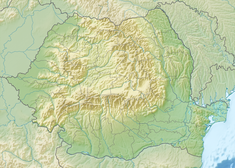
The Itaipu Dam is a hydroelectric dam on the Paraná River located on the border between Brazil and Paraguay. It is the third largest hydroelectric dam in the world, and holds the 45th largest reservoir in the world.

The Iron Gates is a gorge on the river Danube. It forms part of the boundary between Serbia and Romania (north). In the broad sense it encompasses a route of 134 km (83 mi); in the narrow sense it only encompasses the last barrier on this route, just beyond the Romanian city of Orșova, that contains two hydroelectric dams, with two power stations, Iron Gate I Hydroelectric Power Station and Iron Gate II Hydroelectric Power Station.

Đerdap National Park stretches along the right bank of the Danube River from the Golubac Fortress to the dam near Novi Sip, Serbia. It was established in 1974 and spreads on 63,786.5 ha. The park management office is in the town of Donji Milanovac on the Danube. Across the river is the Parcul Natural Porțile de Fier in Romania.

Kladovo is a town and municipality located in the Bor District of eastern Serbia. It is situated on the right bank of the Danube river.

The Bureya Dam is a hydroelectric dam on the Bureya River in the Russian Far East.

Donji Milanovac is a town in eastern Serbia. It is situated in the Majdanpek municipality, in the Bor District. It is located on the right bank of Lake Đerdap on the Danube. The population of the town is 2,410 people. Its name means "Lower Milanovac".
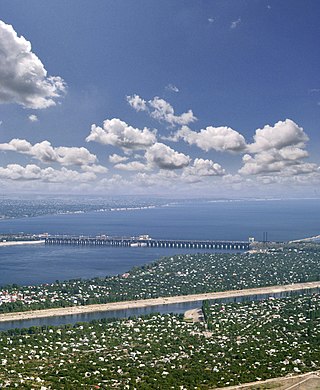
The Volga Hydroelectric Station or Volga GES also known as the 22nd Congress of the CPSU Stalingrad/Volgograd Hydroelectric Power Station, is the largest hydroelectric station in Europe, and the last of the Volga-Kama Cascade of dams, immediately before the Volga River flows into the Caspian Sea. It was the largest powerstation in the world between 1960 and 1963. Today, it is operated by the partly government-owned electricity company RusHydro.

The Sayano-Shushenskaya Dam is located on the Yenisei River, near Sayanogorsk in Khakassia, Russia. It is the largest power plant in Russia and the 12th-largest hydroelectric plant in the world, by average power generation. The full legal name of the power plant, OJSC [Open Joint-Stock Society] P. S. Neporozhny Sayano-Shushenskaya HPP [hydro power plant], refers to the Soviet-time Minister of Energy and Electrification Pyotr Neporozhny. As of 2009 the head of the power plant was Valery Kyari.

The Nizhny Novgorod Hydroelectric Station or Nizhny Novgorod GES is a hydroelectric station on the Volga river. Located near Zavolzhye, Nizhny Novgorod Oblast, it belongs to the Volga-Kama Cascade of dams.
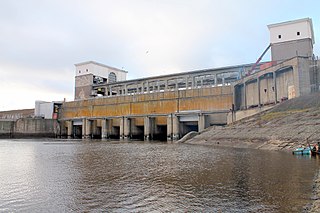
Rybinsk Hydroelectric Station or Rybinsk GES is a hydroelectric station on the Volga and the Sheksna rivers in Yaroslavl Oblast near the Rybinsk town. It is the third of the Volga-Kama Cascade of dams.
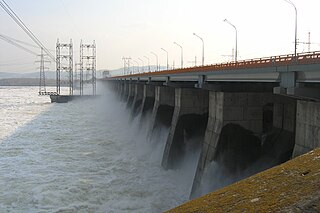
The Zhiguli Hydroelectric Station or Zhigulyovskaya Hydroelectric Station, formerly known as Kuybyshev Hydroelectric Station is a large dam and hydroelectric station on the Volga River, located near Zhigulyovsk and Tolyatti in Samara Oblast of Russia. It is the sixth stage of the Volga-Kama Cascade of dams, and the second of them by in terms of installed power quantum.
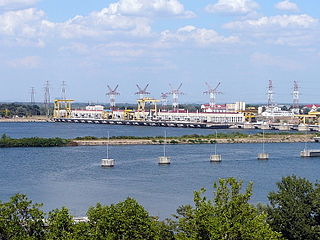
The Iron Gate II is a large dam on the Danube River, between Romania and Serbia.
Romania is the 38th largest energy consumer in the world and the largest in South Eastern Europe as well as an important producer of natural gas, oil and coal in Europe.

The Boguchany Dam is a large hydroelectric dam on the Angara River in Kodinsk, Krasnoyarsk Krai, Russia. It has an installed capacity of 2,997 MW. Construction of the power plant was completed when a ninth and final generator was brought online in January 2015.
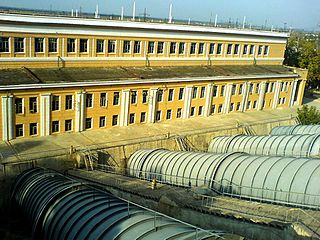
The Farkhad Dam is a hydroelectric and irrigation dam on the Spitamen in Sughd Province, Tajikistan. It is a part of the Naryn-Syr Darya Cascade. The dam is located on the territory of Tajikistan and controlled by Tajikistan, while the Farkhad hydropower station, operated by Uzbekenergo.

The Zeya Dam is a concrete gravity dam on the Zeya River by the town of Zeya, Amur Oblast, Russia, north of the Chinese border. On average the Zeya Hydroelectric Power Station generates 4.91 TWh of electricity per year. It is equipped with 6 hydro-turbines, 4 with capacity of 225 MW and 2 with capacity of 215 MW.

Hydropower is the most used form of renewable energy in Russia, and there is large potential in Russia for more use of hydropower. According to the International Hydropower Association Russia is the seventh largest producer of hydroelectricity in 2020. It is also second in the world for hydro potential, yet only 20% of this potential is developed. Russia is home to 9% of the world's hydro resources, mostly in Siberia and the country's far east. At the end of 2005, the generating capacity from hydroelectric sources in Russia was 45,700 MW, and an additional 5,648 MW was under construction. The World Energy Council believes that Russia has much potential for using its hydro resources, with a theoretical potential of about 2,295 TWh/yr, with 852 TWh being economically feasible.
The Kayrakkum Dam, also spelt variously as Kayrakum, Kairakum, Qayraqqum or Qayroqqum, is an embankment dam on the Syr Darya River near the town of Kayrakkum in Sughd Province, Tajikistan. It is situated on the western edge of the Fergana Valley and creates Kayrakkum Reservoir. The reservoir supplies water for irrigation, primarily in Uzbekistan downstream, and hydroelectric power production. The reservoir is also a Ramsar site. The dam's power station has an installed capacity of 126 MW and is operated by Barki Tojik. Construction on the dam began in 1952. It began to impound its reservoir in 1956 and the first two generators were commissioned that year. The other four were operational in 1957 and the project was complete in 1959. The power station is currently undergoing a rehabilitation which should be completed in 2020. Two new and larger turbines will increase the installed capacity to 142 MW.

Iron Gate III or Đerdap III is a planned pumped storage power station on the Danube in Serbia, near the village of Dobra in the Golubac municipality. It would be the third Iron Gate power station, after Iron Gate I in 1972 and Iron Gate II in 1985. Unlike the first two, which were joint projects of Yugoslavia and Romania, the Iron Gate III would lie entirely on Serbian territory.


